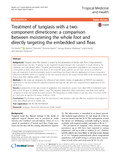Treatment of tungiasis with a twocomponent dimeticone: a comparison between moistening the whole foot and directly targeting the embedded sand fleas

View/
Date
2017Author
Nordin, P.
Thielecke, M.
Ngomi, Nicholas N.
Mudanga, G. M.
Krantz, I.
Feldmeier, H.
Metadata
Show full item recordAbstract
Background: Tungiasis (sand flea disease) is caused by the penetration of female sand fleas (Tunga penetrans, Siphonaptera) into the skin. It belongs to the neglected tropical diseases and is prevalent in South America, the Caribbean and sub-Saharan Africa. Tungiasis predominantly affects marginalized populations and resource-poor communities in both urban and rural areas. In the endemic areas, patients do not have access to an effective and safe treatment. A proof-of-principle study in rural Kenya has shown that the application of a two-component dimeticone (NYDA®) which is a mixture of two low viscosity silicone oils caused almost 80% of the embedded sand fleas to lose their viability within 7 days.
Methods: In this study we compared the efficacy of two distinct modes of application of NYDA®; one targeted application to the area where the parasite protrudes through the skin and one comprehensive application to the whole foot.
Results: Independent of the two modes of application, the dimeticone caused more than 95% of embedded sand fleas to lose all signs of viability within 7 days. The targeted application killed embedded sand fleas more rapidly compared to when the whole foot was covered. The proportion of viable lesions at day two were 7.0 versus 23.4% (p < 0.01) and at day five 3.9 versus 12.5% (p < 0.02).
Conclusions: Our findings suggest that the dimeticone could provide a safe and effective treatment for tungiasis in areas with difficult access to health care.
URI
https://www.scienceopen.com/document?vid=b6f0e457-2e7f-44d5-8a89-d3973ace115dhttps://tropmedhealth.biomedcentral.com/articles/10.1186/s41182-017-0046-9
https://www.researchgate.net/publication/314509803_Treatment_of_tungiasis_with_a_two-component_dimeticone_A_comparison_between_moistening_the_whole_foot_and_directly_targeting_the_embedded_sand_fleas
https://www.diva-portal.org/smash/record.jsf?pid=diva2%3A1092481&dswid=3230
https://go.gale.com/ps/anonymous?id=GALE%7CA603080705&sid=googleScholar&v=2.1&it=r&linkaccess=abs&issn=13494147&p=AONE&sw=w
https://www.semanticscholar.org/paper/Treatment-of-tungiasis-with-a-two-component-a-the-Nordin-Thielecke/9ca0580aab91b67ff97c9be6463bb99549fb2d02
https://www.scienceopen.com/document?vid=b6f0e457-2e7f-44d5-8a89-d3973ace115d
http://hdl.handle.net/123456789/4549
Collections
- Journal Articles (PAS) [303]
